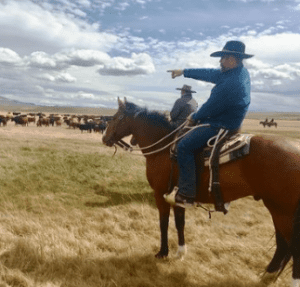Targeted Grazing
View the Progress Report.
In 2015, the Bureau of Land Management implemented a call to action with the release of the Integrated Rangeland Fire Management Strategy (IRFMS) to improve the efficiency and efficacy of actions to address rangeland fire, to better prevent and suppress rangeland fires, and improve efforts to restore fire-impacted landscapes. The IRFMS specifically addresses the need to explore targeted livestock grazing as a strategic fine fuels reduction option. This report describes the progress made on these actions to date.
Read webinar brief.
Brian Mealor, Associate Professor and Director of the Sheridan Research and Extension Center, UW, discusses strategic opportunities where land managers can intervene to move the needle on cheatgrass. It describes the level of invasion and management strategies applicable to each. Then, Mike Pellant, Ecologist, Retired BLM, discusses post-fire opportunities, cheatgrass die-off areas, and the myths and realities of dormant season targeted grazing.
This webinar was the fourth in our 2018 Webinar Series: Moving the Needle on Cheatgrass: Putting What We Know into Practice.
View webinar recording.
This webinar discusses how targeted grazing can reduce fuels to prevent wildfire in shrub-grasslands. Chris Schachtschneider, Eva Strand, and Scott Jensen, University of Idaho, present.
Read webinar brief.
Brian Mealor, Associate Professor and Director of the Sheridan Research and Extension Center, UW, discusses strategic opportunities where land managers can intervene to move the needle on cheatgrass. It describes the level of invasion and management strategies applicable to each. Then, Mike Pellant, Ecologist, Retired BLM, discusses post-fire opportunities, cheatgrass die-off areas, and the myths and realities of dormant season targeted grazing.
This webinar was the fourth in our 2018 Webinar Series: Moving the Needle on Cheatgrass: Putting What We Know into Practice.
Access article.
This study evaluated how targeted grazing treatments interacted with seed rate, spatial planting arrangement (mixtures vs. monoculture strips), seed coating technology, and species identity (five native grasses) to affect standing biomass and seeded plant density in experimental greenstrips.
View webinar recording.
The webinar “An All Lands Approach to Grazing Management” examined cross-boundary strategies for cooperative grazing management between a variety of federal and state agencies in Idaho. These efforts seek to achieve a more flexible management system across ownership boundaries to better respond to various rangeland challenges. Moderator: Curtis Elke, State Conservationist for Idaho, USDA-Natural Resource Conservation Service. Panelists: Karen Launchbaugh, Director, University of Idaho Rangeland Center; Dustin Miller, Administrator, Idaho Governor’s Office of Species Conservation; Chris Black, Chair, Board of Directors, Idaho Rangeland Resource Commission; June Shoemaker, Idaho State Director for Resources, Bureau of Land Management. This webinar is part of the series for the National Forest and Rangeland Management Initiative, the Chairman’s Initiative of WGA Chair and Montana Gov. Steve Bullock.
View article.
Heavy late-fall grazing by sheep following spring deferment improves deteriorated sagebrush-grass ranges by reducing sagebrush and increasing the production of grasses and forbs. Fall grazing as a method for range improvement is more effective and practical than complete protection from grazing and is less expensive than mechanical or chemical means of sagebrush control. Heavy spring grazing damages good-condition ranges by increasing sagebrush and reducing herbaceous production.
View article.
The objective of this study was to investigate how climate, land use and community structure may explain these patterns of species dominance. We found that differences in summer precipitation and winter minimum temperature, land use intensity, and shrub size may all contribute to the dominance of annual species in the Great Basin, particularly cheatgrass. In particular, previous work indicates that summer precipitation and winter temperature drive the distribution of cheatgrass in the Great Basin. As a result, sites with wet summers and cold springs, similar to the Chinese sites, would not be expected to be dominated by cheatgrass. A history of more intense grazing of the Chinese sites, as described in the literature, also is likely to decrease fire frequency, and decreases litter and shrub dominance, all of which have been demonstrated to be important in cheatgrass establishment and ultimate dominance. Further research is necessary to determine if other annuals that follow the same pattern of scarcity in the Junggar Basin and dominance in the Great Basin are responding to the same influences.
View article.
Sage-grouse obtain resources for breeding, summer, and winter life stages from sagebrush communities. Grazing can change the productivity, composition, and structure of herbaceous plants in sagebrush communities, thus directly influencing the productivity of nesting and early brood-rearing habitats. Indirect influences of livestock grazing and ranching on sage-grouse habitat include fencing, watering facilities, treatments to increase livestock forage, and targeted grazing to reduce fine fuels. To illustrate the relative value of sagebrush habitats to sage-grouse on year-round and seasonal bases, we developed state and transition models to conceptualize the interactions between wildfire and grazing in mountain and Wyoming big sagebrush communities. In some sage-grouse habitats, targeted livestock grazing may be useful for reducing fine fuels produced by annual grasses. We provide economic scenarios for ranches that delay spring turnout on public lands to increase herbaceous cover for nesting sage-grouse. Proper rangeland management is critical to reduce potential negative effects of livestock grazing to sage-grouse habitats.
View article.
The key to grazing that will enhance watershed dynamics is encompassed in the basic ingredients of watershed management, i.e., managing for water efficiency. These ingredients, which have been stated by Barrett (1990), are to CAPTURE, STORE, and SAFELY RELEASE water on watersheds.




